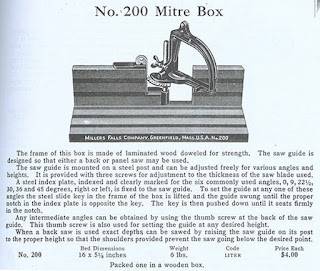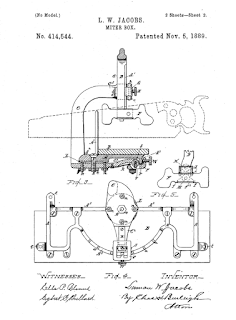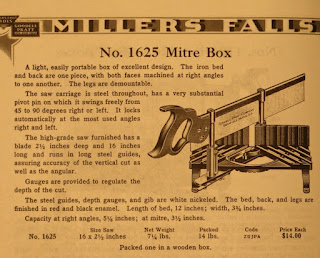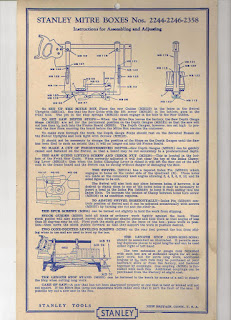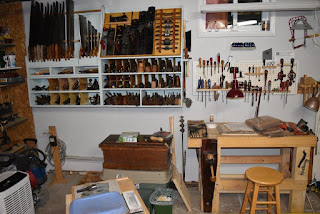Joint making planes
These are the ones that makes quick work of making or tuning up joinery. Not necessary, you could cut all the joints armed with only a saw and a chisel, but they sure make your job easier and faster, hence why I consider them into my minimalist list.
Many joints are made up of grooves, rabbet and dadoes,
sometimes in combination.
The Dado Tongue & Rabbet is also called the drawer lock joint, which incidentally is the only other joints I consider for drawers.
Check out
Terry Gordon make a whole drawer with only one plane!
If Terry name sound familiar, it is because he is the maker of HNT Gordon planes in Australia, reputed to be a fine wooden plane maker.
Rabbet plane
From L-R
Stanley No 78, Stanley No 191, ECE rabbet,
Veritas large shoulder plane
Rabbets are one very useful and fundamental joint. It can be used to accept a backer board, or glass. To fit a panel into a groove or be one part of a joint.
Rabbets planes comes in two versions, with the blade square across or with a skewed blade.
Add a fence that slide under and you now have a Fillister plane.
Add a spur cutter ahead of the main cutter and now we have a dado plane, which also never have a fence. Without this spur cutter we would be tearing up cross grain, unable to make a clean cut. By severing the fibers ahead of the cutter action, we have clean walls.
The typical clover leaf spur cutter on numerous metal planes.
There are 4 positions and only 3 cutters, shown all recessed, none cutting.
To engage one, remove screw, rotate cutter (you got 3 choices), put back screw if you managed not to lose it yet... :-)
To sharpen these cutters work on the flat side.
On typical wooden dado plane, the cutters (1 on each sides) are made as one iron as shown here. Note the 2 small spurs sticking out just before the depth stop plate. Notice also the large distance between the spurs and the main blade compared to the metallic one. A dado plane benefit from a skew cutter since we are working cross grain.
Only 1 wedge up front so both spurs are on the same blade.
Sometimes, there is only 1 iron, or 2 separate irons/spurs & wedges.
What started as a simple rabbet plane, is now, with the addition of an adj. depth stop and a cutting spur on each sides, a Dado plane.
They never added fence to them.
Here's the 2 cutting spurs on the same blade.
Problem: if you touch the outside dimensions of the blade, this plane is designed for a 3/4 in dado, it will jam
because the spurs are no longer cutting as large a path as the main cutter blade.
The two must be equal width, or will jam, make a mess etc.
In a pinch you can use a shoulder plane to cut a rabbet, but its low angle and small mouth are meant to cut across the grain while trimming shoulders.
So while a shoulder plane could cut a rabbet, you would be hard pressed to trim shoulders with a rabbet plane. A shoulder plane is a fine tune up tool not a coarse cutting tool like the rabbet plane.
The shoulder plane above has its mouth opened but it is still a lot smaller than the giant one on that rabbet plane.
One of the most inexpensive and useful metallic plane in this category has to be the Stanley No 78. They are plentiful but try to get a complete one; includes the fence and the depth stop, in order to reap the full benefits from it. To buy these parts separately will cost you pretty pennies... More than you paid for the bargain you thought you had. But even without these two accessories, it is still a very useful plane, because it is then simply a Rabbet plane.
Stanley No 78 on top and the similar looking No 191
which is a dedicated rabbet plane.
If you find one, the
Record No 778 is a better tool, owning to its twin post for the fence. The Stanley 78 has a bad habit of having the fence droop no matter how tight you screw it down.
The Stanley No 180 (1-1/2 wide), 181 (1-1/4 wide) and 182 (1 in wide) are the same as the 190 series except that the 190s have a spur on the side, making them more versatile. Like typical rabbet planes, they have no fence provision.
One big advantage of metallic rabbet planes over wooden one is that they won't wear out and remains true to size.
Sometimes you need to tweak that rabbet width, and sure enough, they made planes for that task.
A wooden Side Rabbet plane
A modern take on the classic metallic side rabbet plane from
Veritas
I frankly do not have much use for messing with the grooves width, it is easier to tweak the corresponding tenon or etc.
Small plow plane
From L-R
Veritas small plow, Stanley No 45, Wooden Yankee plow
I choose the smaller size ones such as
Stanley No 50,
Record No 044, and Veritas small plow.
There are
a multitude of options in this category, from the elaborate large wooden plow, to the diminutive metal ones. You could also substitute a Universal plane such as the Stanley 45 or 55, if you happens to be a masochist or just love mechanical contraptions, but honestly, the most used groove in joinery is a 1/4 in wide, 1/4 in deep groove, 1/4 in from them edge.
So yes, you could do easily with a fixed 1/4 in plane. You could make your own or buy such a wooden one either vintage, or new from a boutique maker.
The idea of the small plow is that it can accommodate a variety of cutters and can be adjusted for various sizes "grooves" be it scalloped or reed, flutes etc in addition to making plain square grooves, at various locations from the edge, so it is more versatile, but then you have to buy more cutters and etc...
The 1/4 cutter is by far the the one you will use most, so it is sufficient to start.
Just remember that ANY adjustable planes is only as good as how well it can secure its settings and have easy repeat-ability.
The best and easiest way to set such a plane is by using
setup blocksSet the fence to a 1/4 inch
Set the cutter from cutter tip to depth stop at a 1/4 in
Since the cutter I used the most is a 1/4 in, it is often left in, and the plane set for cutting a 1/4 wide groove, a 1/4 in from the edge, a 1/4 in deep.
Here is some instructions on
how to use them by the Schwarz himselfNext you may want to add some various cutters, as you need them. And if you do, get some sort of means to gather and protect them. A fabric or leather tool roll is a good way.
Router plane
From L-R
Veritas miniature, Stanley No 271, Veritas large (No 71 equivalent)
and Sargent No 62.
Veritas small (No 271 size). it uses the same irons as the large one (71).
Regardless of how you cut a dado, be it with a stack dado set on your tablesaw or by hand with handsaw and chisel, this is the tool you need to make a flat even depth bottom.
It also excel at tuning tenon, the depth of half lapped joints etc.
They basically comes in two sizes (now four thanks to Veritas)
Start with the larger one, Stanley No 71 then later on, as need dictate, the small one Stanley No 271.
You could make a quick and dirty one using a chisel and a block of wood, but the Stanley form is preferable because of the cutting action. Typically the No 71 came with 2 or 3 cutters, the one I used the much is the Spear (pointed) cutter versus the square one. I find it work better in cross grain and allow me to get in corners for tweaking joints. You can uses the
Veritas cutters in the Stanley No 71 and there is also a fence available, which I don't think I ever used....
Notice the one of a kind height adj. thread on the Sargent cutter, far right.
The two Stanley cutters are different vintage. Notice the angle of the square blade is more than 90 to the shaft. I prefer the action of the spear shape one better, and it is more versatile.
Notice the two pieces construction for the spear shape blade.
It sure facilitate sharpening! Hint, put it on a stick...
In case you wondered, YES, the Sargent one had a user mod to salvage it as a cutter. They are unique and hard to find...
Next I would get the smaller one(s), they comes in very handy, depending on what you do. Great for inlays work, and talking of which there is now
adapters for the Veritas large router plane that facilitate that task.
In addition we should mentioned that the large router planes have two holes in the sole, so that you can bridge wider area by adding a wooden sole to these planes.
SPOKESHAVESThese are like small planes with a very small sole. That makes them quick to tuned up. Just like planes take a good look at the bedding area in the metallic ones, it should be flat. A quick work with a file will quickly makes it right, as they are often painted over, rarely machined.
Some people fill the depressions area with epoxy then file the whole thing flat.
It reputedly help damping vibrations (Chatter).
A Stanley No 51 body. The two recessed area under the blade serve no other purpose than to reduce the amount of metal and the subsequent machining
But before we go too far, why a spokeshave? Short answer, unless you work with curves, you will get along just fine without one. But as soon as you venture away from everything square and rectangular, spokeshaves comes in handy...
There are basically two kinds, metallic and wooden ones. The two operate quite differently owning to their construction.
Among the metal ones, the Stanley No 53 and 54 are excellent tool, owing to their adjustable pivoting mouth, adjustable by the big top screw
No 53 has gull wings, while the 54 has straight handles.
If you look closely inside the body, these old Stanley had a machined surface, nowadays they just paint them over the rough casting tsk, tsk.
Traditional wooden ones uses a tang on each end held by a friction fit.
They are adjusted by tapping on the tangs...LIGHTLY
Due to their nature, they wear out at the mouth area which
basically kills them as a precision tools, but...
Either as a retrofit or from new, the better ones have a brass strip inserted at the mouth to negate that problem. If yours does not and has a big gappy mouth, you may be able to salvaged it by adding such a strip.
Adjustable ones in wood are possible, this is the Veritas kit
My all time favourite are the wooden ones. The low cutting angle action can easily peel away wood fibers. Traditionally, they were set with the blade askew. meaning that one post was up a smidgen from the other one. This translate into a skew cutter in relation to the mouth. You can then use one side for a rough cut and move over to the other side for a finer cut. Mind you that trick only works if your work piece is narrower than the blade, if not you just ends up with a tapered cut...
You will notice that the tangs are slightly tapered and being friction fit, it may happen that the hole in the wood body becomes too loose to hold the cutter tight. If/when that happens, try spraying a bit of hair spray in the hole, just a small spritz, and suggest you check with your spouse first... Just saying :-)
Veritas came out with a
metal version that duplicate the cutting action of the older classic wooden ones. You can find vintage Stanley of a similar models, but be prepared for sticker shock...
I specified the Stanley No 151 because it feature a simple mechanism to advance/retract the blade. Easier for beginners to adj. than by tapping the blade, posts, tangs etc. There are of course new premium versions from both
LN and
Veritas If only one, I would get the flat version first, then add to your repertoire by adding various shaped ones as needed... if ever. It all depend on what kind of work you intend to do. But just for the occasional curves work, the No 151 will fit the bill nicely.
SCRAPERS
From L-R
Stanley No 80 (older), Stanley No 80 (newer), Stanley No 81, set of Veritas card scrapers, hand scraper.
The square shape above is newer, while the older one is below.
The Stanley No 81 has a rosewood sole
And unlike the No 80, you cannot bow the blade to increase the cutting action.
The cutter is also a different size, this one is 2-1/2 in wide versus 2-3/4 for the No 80. Since the blade cannot be bowed, it benefit from a thicker cutter than the ones for the No 80.
Scrapers excel at taming wild grain, regardless of the direction you go at it.
I consider a good set of card scrapers a necessity. You are missing on too much if you skip these tools! A set consist usually of three different shapes, allowing them to cover most anything you can throw at it...
My Two-Cherries set, German steel
I have no use for the various holder made for them, I prefer the flexibility of being able to quickly change the bowing action by hands as the need dictates. If your fingers are getting too hot quickly, try using one of those small business card's size fridge magnet promo items, it will insulate your fingers for longer. If you are still overheating, you probably should have spend more time with your planes first... What about wearing gloves you ask? Don't be such a wuss :-)
In many circles Sandvik scrapers are held as the best one, not only because of the famous Swedish steel, but because of the way they were prepared.
The Sandvik No 475 has now been replaced by the
Bahco No 474 and like many good products, it has been outsourced, the newest ones coming from Spain and now Taiwan and not reputed to hold an edge for as long... :-(
Granted, cabinet scraper such as the No 80 or 81 are not essentials, but if you try to use a hand card scraper to do a tabletop, you and your fingers, will quickly appreciated it! Hence depending on the scale of your work, you may never need such a cabinet scraper. They are also sharpened slightly different than regular card scrapers.
Lastly, there are also
scraper planes , but they are rather expensive, and you can get by with only the card scrapers. So add the cabinet scraper then the scraper plane if your work could used it.
Just to recap: When finishing a piece of wood from rough to finish, the sequence would be Jack plane, jointer plane, smoother plane, and if needed to tame some unruly grain area, scrapers, followed by a light sanding using a block. I used 220 grit, just to blend in the plane tracks, scraped area etc. Also, because the planes and scrapers leaves a fine polished and burnished surface, some woods requires
a light sanding to opened up the wood pores to accept stain.
SCRATCH STOCKLV wooden scratch stock
We could argue that such a tool has no place in a "minimalist'' tool list, but it is such an inexpensive and versatile tool that I thought it should. With it you can add a decorative edge like a small bead (for bigger bead a beading plane would be better), flutes and etc. You can buy separate cutters or make your own with a blank and a file.
Once your profile as been cut by your files, simply hone the flat sides to maintain its sharpness. Easy Peasy. You can buy a metal ones such as the
Stanley No 66 or the
new reproduction from LN, or a copy of an
old Preston one from LV or a
wooden one again from LVThere are also very
simple to make with a piece of scrap wood, so there are really no good reasons not to have one in your list... :-)
Next I would start to add moulding planes; Hollow & Rounds, beading planes etc
You don't need the full set, just get the ones you need as you go.
2 or 3 of sizes within your scale of your work should be fine. Unless you do lots of mouldings...
RASPS
Depending on grain size, they could be considered coarse, medium or fine tools.
A good hand stitched rasp is so much better than a machine made one with their identical rows of teeth. The small randomness of hand stitching is what makes them cut much better and finer. Being hand made they are rather expensive ($100 and up) but they are well worth it.
Auriou and
Liogier are two excellent brands, but the good news is there are lots of less expensive options.
My new favourite is the Japanese saw rasp from
Shinto. A two sided tool (coarse and medium). You can save a few bucks by getting just the blade without the holder.
Nicholson used to make the excellent No 49 and No 50 Cabinet maker rasp but sadly like most everything they make these days, they are now crap. The good ones were made in the USA the new ones are from Mexico and China, definitively not made of the same steel!
There are a few good rasps from Italy, Czechoslovakia and other European makers. For a file or rasp to work as good as it can, the steel must be good quality and smooth before they raised the teeth.
I have seen various really cheap ''rasp looking tools'', definitively hand stitched from China and etc but I have no experience with them.
There are also numerous kind of files which can work on wood and leave a good finish. See these
Japanese Mill tooth files. as an example.
Look at the fine steel surface in the uncut area, that's a sign of a good file/rasp.
BTW if you come across a red tang file in your rust hunting, have a closer look, it is probably a vintage Simonds file, excellent ones.
NOS Simonds Multi-kut, leaves a fine surface.
The secret is in the diamond like cuts.
Whatever kind of rasp or file you get, make sure to get a card file to clean them. They don't work good once clogged and rust is sure to start if they are clogged so please take care of them. Protect them in storage, don't let them bang around each other in storage etc. Like any files, rasps work on the push stroke, don't drag the teeth on the return stroke, the teeth will last longer. Good ones are not cheap, be nice to them...
Next part we will look at saws and chisels
Bob, wishing you the luck of the Irish. We could have used some of that :-(




























